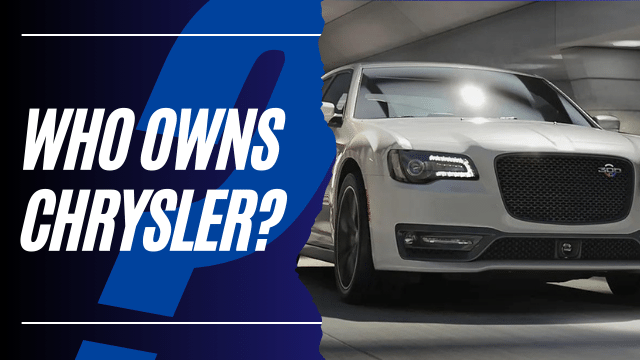In the dynamic landscape of the US automotive industry, an intriguing question often arises: Who is the current owner of Chrysler? This renowned American automaker has undergone a fascinating journey of ownership and transformations. If you’re a car enthusiast eager to delve into the history of Chrysler’s ownership, you’re in the right place. We’ll explore the current owner of Chrysler, the location of its manufacturing facility, its mergers with other companies, and more.
Founded by Walter Chrysler in 1925, Chrysler has solidified its place as an iconic American automobile manufacturer. Throughout its rich history, the company has introduced a diverse range of vehicles, including sedans, SUVs, and minivans. Notably, Chrysler achieved a milestone with the invention of the high-performance HEMI engine.
As one of the “Big Three” American automakers, alongside General Motors and Ford, Chrysler holds a prominent position, shaping the landscape of the car and truck markets and leaving a lasting impact on the global automotive industry.
The automotive industry has witnessed a continual cycle of manufacturers acquiring, selling, or discontinuing brands over the years. Are you curious about Chrysler’s fate? Let’s delve into the intricate details of Chrysler’s ownership history.
Who bought Chrysler corporation?
Presently, Stellantis, a multinational automotive giant, is the proud owner of Chrysler. Stellantis is not only responsible for Chrysler but also handles the distribution of vehicles under renowned brands such as Dodge, Jeep, and Ram. The formation of Stellantis took place in 2021 when Italian American automaker Fiat Chrysler Automobiles joined forces with the French automaker PSA Group (Peugeot Société Anonyme).
Fast forward to December 2022, Stellantis has secured the third position among the world’s largest car manufacturers, standing tall behind Volkswagen Group and Toyota in the rankings.
Which brands does Stellantis currently own?
Stellantis’ Brand Portfolio and Chrysler Manufacturing Locations
Stellantis Brand Lineup: Stellantis, a powerhouse in the automotive industry, encompasses a diverse array of 14 renowned automobile companies and two mobility arms. This constellation boasts a lineup of well-known brands hailing from France, Italy, and the United States. Notable additions to the Stellantis family include Abarth, Chrysler, Dodge, DS, Fiat, Jeep, Maserati, Mopar, Peugeot, Ram, and more. Stellantis North America proudly represents three iconic American marques: Dodge, Ram, and Chrysler.
Where are Chryslers manufactured?
Chrysler Manufacturing Locations: The production hub for Chrysler vehicles centers around the Jefferson North Assembly plant, located in the heart of Detroit, Michigan. While specific Chrysler models find their origins in the Toluca Car Assembly plant in Toluca, Mexico, the core of Chrysler’s manufacturing remains firmly rooted in Detroit.
Chrysler operates three key production facilities strategically positioned in Canada, the United States, and Mexico. The bulk of Chrysler’s components roll off the production lines at two Canadian locations. Notably, the Pentastar Engine, a hallmark of Chrysler’s performance, undergoes manufacturing at two distinct sites: the Trenton Engine facility in Trenton, Michigan, and the Saltillo South Engine plant in Saltillo, Mexico.
A shift in Chrysler’s production landscape was marked by Fiat Chrysler Automobiles’ decision to cease U.S. production in early 2017. This move redirected Chrysler vehicle manufacturing to Mexico, a cost-effective alternative in the automotive industry.
Chrysler, forming part of a conglomerate boasting an extensive brand collection, sees its vehicles manufactured alongside Dodges, Rams, Jeeps, and Fiats in various plants. The operational control of these manufacturing facilities remains under the umbrella of the Fiat Chrysler Automobiles group, with a global footprint spanning the United States, South America, Europe, India, and China.
What is the last company Chrysler merged with?
Chrysler’s Recent Merger and the Birth of Stellantis
In the recent evolution of the automotive industry, Chrysler, formerly recognized as Fiat Chrysler, underwent a transformative merger in 2021. This strategic union involved joining forces with the parent company of the Peugeot brand, culminating in the creation of the automotive powerhouse known as Stellantis.
Under the expansive Stellantis umbrella, a diverse array of well-established brands finds their place. Noteworthy names such as Chrysler, Dodge, Fiat, Fiat Professional, Jeep, Ram, Alfa Romeo, Abarth, Lancia, and Maserati all fall under the Stellantis conglomerate. This merger has not only redefined Chrysler’s corporate landscape but has also positioned Stellantis as a prominent player in the dynamic and ever-evolving automotive market.
Did Chrysler merge with Daimler?
Chrysler’s Collaboration with Daimler: A Strategic Merger
In a strategic move to bolster their positions in the automotive industry during challenging economic times, Daimler-Benz and Chrysler Corporation joined forces to navigate the crisis collectively.
The pivotal announcement came in May 1998 when Chrysler Corporation and Daimler-Benz AG disclosed their intentions to merge. This monumental decision involved Daimler-Benz acquiring the American automaker through a stock swap, a transaction valued at over $35 billion. Subsequently, both companies’ shareholders endorsed the merger in September, and the finalization of this transformative collaboration occurred in November. This strategic alliance marked a significant chapter in the automotive landscape, showcasing the industry’s adaptability to economic challenges through collaborative endeavors.
Why did Daimler and Chrysler’s merger fail?
Factors Behind the Unsuccessful Merger of Daimler and Chrysler
Despite Daimler-Benz AG’s acquisition of Chrysler Corp for a substantial $36 billion, the envisioned success of the merger never materialized. DaimlerChrysler encountered significant hurdles, including persistent cost-cutting measures and lackluster sales performance of Chrysler models.
Adding to the complexities, Daimler Chrysler faced mounting pressure from German stakeholders who expressed concerns that the underperformance of the American brand was negatively impacting the reputation and success of Mercedes and Maybach, further complicating the synergy between the two automotive giants. This amalgamation, which held great promise, ultimately faltered under the weight of operational challenges and strategic misalignments.
FAQs
Are Chryslers American made?
Absolutely, Chrysler vehicles are proudly manufactured in the United States. Established in 1925 and headquartered in Auburn Hills, Michigan, Chrysler has solidified its American roots. The company operates three manufacturing plants strategically located in the United States, Canada, and Mexico.
When did Fiat buy Chrysler?
Fiat assumed ownership of Chrysler between 2011 and 2014. Taking the majority stake in 2011 from the US Treasury, Fiat completed the acquisition of the brand on January 21, 2014. This pivotal moment led to the amalgamation of both names, giving rise to the current identity, Fiat Chrysler Automobiles.
Why does Fiat own Chrysler?
Fiat’s acquisition of Chrysler transpired amidst the aftermath of the Great Recession when Chrysler faced financial challenges, necessitating financial support from the American and Canadian governments. However, this alliance was ephemeral. In 2021, Fiat Chrysler joined forces with Stellantis, a Dutch-based automotive company, to enhance competitiveness. Presently, the corporation boasts a global presence, employing over 300,000 individuals and catering to automotive markets in 130 countries.
Does Chrysler own Mercedes?
Contrary to popular belief, Chrysler did not own Mercedes-Benz. In 1998, Mercedes’ parent company, Daimler-Benz, acquired Chrysler in a $36 billion merger. The initial vision was to create a comprehensive empire, positioning Chrysler as the practical alternative and Mercedes-Benz as the premium brand, akin to the relationship between Toyota and Lexus. However, due to a significant lack of synergy and unfavorable market conditions, Chrysler faced bankruptcy in 2006.
Does Chrysler own Dodge and RAM?
No, Chrysler is distinct from Dodge, and Chrysler no longer owns the Dodge brand. Stellantis, the parent company overseeing Chrysler and Dodge, also holds the reins of renowned brands such as Jeep and RAM. In 2009, Dodge and RAM underwent a separation, with RAM emerging as a standalone brand renowned for its exceptional lineup of pickup trucks.


